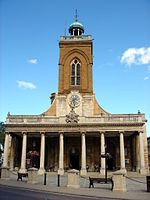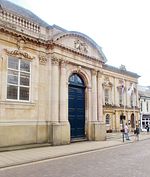Northampton Bridge Street railway station
Beeching closures in EnglandDisused railway stations in NorthamptonshireEast Midlands railway station stubsFormer London and Birmingham Railway stationsJohn William Livock buildings ... and 4 more
Pages with no open date in Infobox stationRailway stations in Great Britain closed in 1964Railway stations in Great Britain opened in 1845Use British English from June 2014

Northampton Bridge Street is a former railway station in Northampton, the main town of Northamptonshire, on the Northampton and Peterborough Railway which connected Peterborough and Northampton.
Excerpt from the Wikipedia article Northampton Bridge Street railway station (License: CC BY-SA 3.0, Authors, Images).Northampton Bridge Street railway station
Old Towcester Road,
Geographical coordinates (GPS) Address External links Nearby Places Show on map
Geographical coordinates (GPS)
| Latitude | Longitude |
|---|---|
| N 52.229 ° | E -0.8975 ° |
Address
Northampton Bridge Street
Old Towcester Road
NN4 8EL , Far Cotton and Delapre
England, United Kingdom
Open on Google Maps










